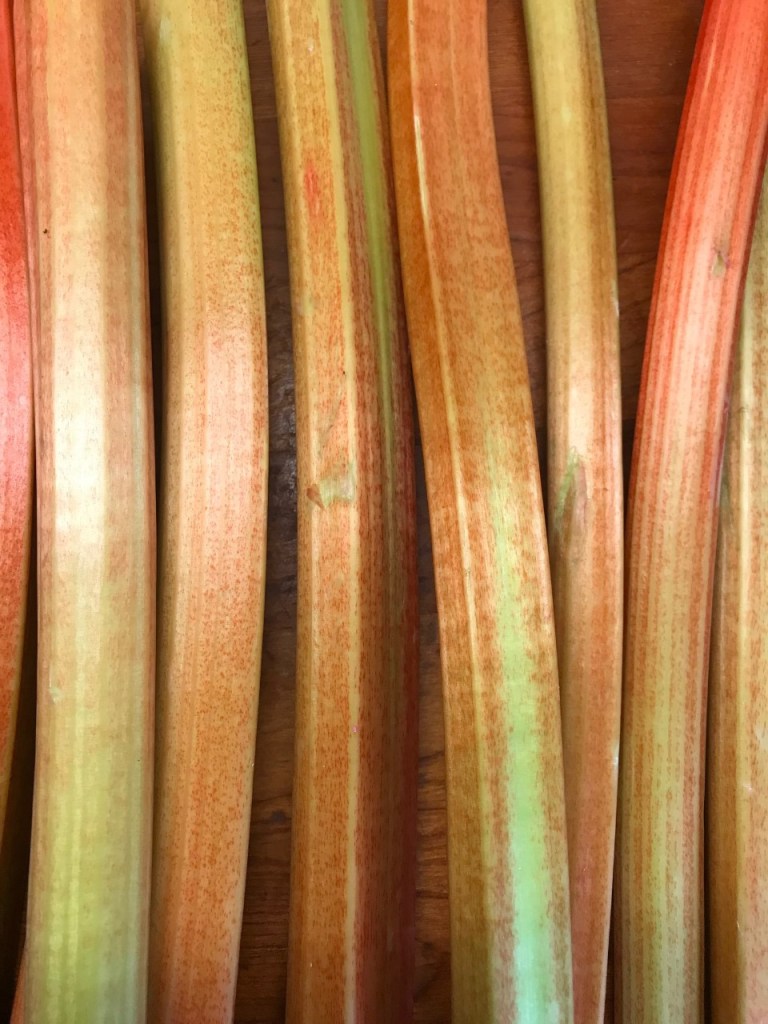
- Easy Shortbread Recipe
- Cranberry Gin
- Beetroot Soup with Coconut
- Leek and Potato Soup with Fresh Chives
- Blackberry Gin
Rhubarb and Vanilla Jam
This quick and easy Rhubarb Jam, flavoured with vanilla, is tangy and delicious. Rhubarb has a long season, from early spring through to September. It is a great way to use up rhubarb if, like me, you have an over-supply in your garden.
What you need to know about Rhubarb and Vanilla jam
- It is a very simple recipe which only uses three ingredients – rhubarb, sugar and a vanilla pod.
- Try and use jam sugar rather than regular caster sugar. Jam sugar has added pectin which means that the jam will set quickly without you having to cook the fruit for too long. This preserves the flavour.
- Make sure you sterilise your jam jars before putting the jam into them. This will ensure that the jam lasts longer.
- The quantities in this recipe results in one large jar of jam. It is very easy to multiply the ingredients if you want to make more jam. As rhubarb is quite tart, the rule of thumb is to have equal weights of raw rhubarb and sugar.
- I use a vanilla pod to flavour this jam as I think the flavour goes very well with rhubarb. However, if vanilla is not your thing, you can leave it out and just make plain rhubarb jam. It will still taste very good. Alternatively, you can add another flavouring. Cardamon and star anise both go very well with rhubarb – just substitute three dried cardamon pods or two dried star anise pods for the vanilla pod.
- This Rhubarb Jam is lovely on buttered bread. However, as with all jams, it can also be used as an ingredient in other recipes. It is a good filling for cakes or to add a tang to puddings such as my Bread and Butter Pudding with Rhubarb Jam.
Other jam and preserve recipes
Making your own jam and preserves is really easy. They taste delicious, keep for a long time and also you know exactly what is in them. You can moderate the sugar content and also be sure that there are no artificial preservatives. It is also a great way to use a seasonal over-supply of a particular fruit.
My home-made jam recipes use seasonal ingredients and often have a bit of a flavour twist. For example, my Strawberry Jam is flavoured with rose geranium. I have some simple jams such as my classic Gooseberry Jam.
Some of my other preserve recipes are a bit more unusual. I make a delectable Rose Petal Jam which can be used in lots of different ways. I also have a Chilli Jam which is fantastic as a dip or with savoury dishes.
I also have a few recipes for fruit curds including a fool-proof recipe for classic Lemon Curd. Fruit curds are brilliant cooking ingredients in everything from ice cream to cakes.
Other rhubarb recipes
I love the sweet-sour taste of rhubarb and, as I have a vigorous plant in my garden, I make lots of recipes with it.
In addition to this jam, I also make Rhubarb Curd which is great on a slice of bread but can also be used in other recipes such as Rhubarb Curd and Rose Ice-cream or as a filling for my Rhubarb and Vanilla Victoria Sandwich Cake.
I also make Rhubarb Compote which is like an unset jam made from a simple mixture of rhubarb and sugar. It is great stirred into yogurt or served with ice cream but can also be used as an ingredient in recipes such as Rhubarb Roulade or Rhubarb Fool.
I also use rhubarb in a good old-fashioned Rhubarb Crumble and also in Rhubarb Crumble Cake which is a simple loaf cake with a crunchy crumble topping.
Finally, I use rhubarb to make Rhubarb Gin which is great on its own or as the basis for a number of Rhubarb Gin Cocktails. It is really easy to make flavoured gin which is much cheaper than premium shop-bought brands.
Loved this recipe? Checkout the Recipe Index.

Rhubarb and Vanilla Jam recipe
Print
Rhubarb and Vanilla Jam
- Prep Time: 15
- Cook Time: 15
- Total Time: 30 minutes
- Yield: 1 large jam jar 1x
- Category: Jam
- Cuisine: English
Description
This tangy Rhubarb Jam, flavoured with vanilla, is delicious and very easy to make.
Ingredients
- 600 g (1 lb) rhubarb
- 600 g (1 lb) jam sugar (with added pectin)
- 1 vanilla pod
Instructions
- Wash your rhubarb and cut into 2 cm (1 inch) pieces.
- Put the pieces into your saucepan along with the sugar.
- Cook on a low heat so that the fruit releases its juices and the sugar dissolves. Add the vanilla pod.
- Turn up the heat so that the mixture is bubbling and cook for around 15 minutes. By this time, it should be thickened.
- Sterilise your jam-jar and then pour the jam mixture into it. Allow to cool and then cover with a lid.
Notes
You can sterilise your jam jar by washing in warm, soapy water and then rinsing well and allowing to dry off for 15 minutes in an oven set to 140C/120C fan/gas 1.
This jam will keep for six months if the jar is kept unopened. Once you have opened the jar, keep it in the fridge and eat the jam within a month.
Keywords: rhubarb, jam
Loved this recipe? Checkout the Recipe Index.































